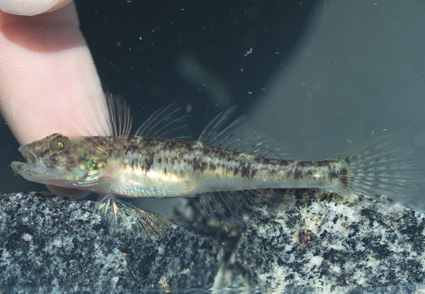Abstract
Glossogobius giuris was originally described as Gobius giuris from the Ganges River, India. However, based on the uncertainty of its type locality and its apparent widespread distribution, a comprehensive study is being carried out to define the correct taxonomic status of this taxon. The South African population of the Glossogobius from St. Lucia Lake, KwaZulu-Natal was described as Glossogobius tenuiformis by Fowler in 1934. It has usually been considered as Glossogobius giuris but Hoese and Hammer indicated that it was a distinct species (2021: 83). Here, based on morphological characters and a molecular data set, we redescribe Glossogobius tenuiformis and assign the Oman populations of Glossogobius to this species. Glossogobius tenuiformis is distinguished from G. giuris by the absence or very short (and often only a few papillae long) sensory papilla line 6; presence of single rows of the sensory papillae in each cheek line, 12–16 pre-dorsal scale counts, and 1+1+9–11, usually 1+1+10, gill rakers on outer face of first arch. Glossogobius tenuiformis is also distinguished by molecular characters. Glossogobius tenuiformis shows 16% genetic distance with other members of this species complex, that includes G. laticeps from Vietnam, Bangladesh and China, G. giuris from South Africa and India and “giuris C” from India, Myanmar, Nepal, Bangladesh and Vietnam, and the highest genetic distance (24%) with G. circumspectus.
References
Akihito, P., Meguro, K. (1975) Description of a new gobiid fish, Glossogobius aureus, with notes on related species of the genus. Japanese Journal of Ichthyology, 22, 127–142. https://doi.org/10.11369/JJI1950.22.127
Bruford, M.W., Hanotte, O., Brokfield, J.F.Y. & Burke, T. (1992) Single–locus and multilocus DNA fingerprinting. In: Hoelzel, A.R. (Ed.), Molecular genetic analysis of populations: a practical approach. Oxford University Press, New York, New York, pp. 225–269.
Darriba, D., Taboada, G.L., Doallo, R. & Posada, D. (2012) jModelTest 2: More models, new heuristics and parallel computing. Nature Methods, 9, 772. https://doi.org/10.1038/nmeth.2109
Fowler, H.W. (1934) Fishes obtained by Mr. H. W. Bell-Marley chiefly in Natal and Zululand in 1929 to 1932. Proceedings of the Academy of Natural Sciences of Philadelphia, 86, 405–514.
Fricke, R., Eschmeyer, W.N. & Laan, R. van der. (Eds.) (2022) Catalog of Fishes: Genera, Species, References. Available from: http://researcharchive.calacademy.org/research/ichthyology/catalog/fishcatmain.asp (accessed 30 January 2022)
Freyhof, J., Els, J., Feulner, G.R., Hamidan, N. & Krupp, F. (2020) Freshwater fishes of the Arabian Peninsula. Motivate Media Group, Dubia, 272 pp.
Hall, T.A. (1999) BioEdit: a user-friendly biological sequence alignment editor and analysis program for Windows 95/98/NT. Nucleic Acids Symposium Series, 41, 95–98.
Hammer, M.P., Taillebois, L., King, A.J., Crook, D.A., Wedd, D., Adams, M., Unmack, P.J., Hoese, D.F. & Bertozzi, T. (2021) Unravelling the taxonomy and identification of a problematic group of benthic fishes from tropical rivers (Gobiidae: Glossogobius), Journal of Fish Biology, 99, 87–100. https://doi.org/10.1111/jfb.14701
Hoese, D.F. (1986) Family No. 240: Gobiidae + Family No. 241: Eleotridae + Family No. 242: Kraemeriidae. In: Smith, M.M. & Heemstra, P.C. (Eds.), Smiths’ Sea Fishes. Macmillan South Africa, Johannesburg, pp. 774–807, pls. 122–126 + pp. 807–811, pl. 127 + pp. 811.
Hoese, D.F. & Larson, H.K. (2006) Gobiidae. In: Hoese, D.F., Bray, D.J., Paxton, J.R. & Allen, G.R. (Eds.), Zoological Catalogue of Australia, 35, pp. 1612–1697.
Hoese, D.F. & Allen, G.R. (2009) Description of three new species of Glossogobius from Australia and New Guinea. Zootaxa, 1981, 1–14.
Hoese, D.F. & Hammer, M.P. (2021) A review of the Glossogobius giuris complex in Australia, with wider discussion on nomenclature and possible synonymies. Zootaxa, 4974 (1), 79–115. https://doi.org/10.11646/zootaxa.4974.1.3
Hoese, D.F., Hadiaty, R.K. & Herder, F. (2015) Review of the dwarf Glossogobius lacking head pores from the Malili lakes, Sulawesi, with discussion of the definition of the genus. Raffles Bulletin of Zoology, 63, 14–26.
Hoese, D.F., Allen, G.R. & Hadiaty, R.K. (2017) Description of three new species of dwarf Glossogobius from New Guinea and northern Australia. Cybium, 41, 179–193. https://doi.org/10.26028/cybium/2017-412–009
Kimura, M. (1980) A simple method for estimating evolutionary rates of base substitutions through comparative studies of nucleotide sequences. Journal of Molecular Evolution, 16, 111–120. https://doi.org/10.1007/BF017 31581
Larson, H.K. & Murdy, E.O. (2001) Families Eleotridae, Gobiidae. In: Carpenter, K.E. & Niem, V.H. (Eds.), The living marine resources of the western central Pacific. FAO species identification guide for fisheries purposes, 6, 3574–3603.
Kumar, S., Stecher, G. & Tamura, K. (2016) MEGA7: Molecular evolutionary genetics analysis version 7.0 for bigger datasets. Molecular Biology and Evolution, 33, 1870–1874. https://doi.org/10.1093/molbe v/msw054
Maake, P.A. (2009) MSC thesis. Molecular systematics of the South African gobiid fishes of the genus Glossogobius Gill, 1862 (Teleostei: Gobiidae). University of Limpopo, Mankweng, Limpopo, 222 pp. [http://hdl.handle.net/10386/538]
Maugé, A.L. (1986) Atherinidae + Ambassidae + Kuhliidae + Gobiidae + Eleotridae + Periophthalmidae. In: Daget et al. 1986. Check-list of the freshwater fishes of Africa. CLOFFA. Vol. 2. ISNB, Bruxelles, MRAC, Tervuren, ORSTOM, Paris, pp. 277–279 + pp. 297–298 + pp. 306–307 + pp. 58–388 + pp. 389–398 + pp. 399–401.
Ronquist, F., Teslenko, M., Van Der Mark, P., Ayres, D. L., Darling, A., Höhna, S., Larget, B., Liu, L., Suchard, M.A. & Huelsenbeck, J.P. (2012) MrBayes 3.2: Efficient Bayesian phylogenetic inference and model choice across a large model space. Systematic Biology, 61, 539–542. https://doi.org/10.1093/sysbi o/sys029
Schliewen, U.K. & Kovačić, M. (2008) Didogobius amicuscaridis spec. nov. and D. wirtzi spec. nov., two new species of symbiotic gobiid fish from São Tomé and Cape Verde islands. Spixiana, 31, 247–261.
Smith, J.L.B. (1937) New records of South African fishes. Annals of the Natal Museum 8,167-197.
Stamatakis, A. (2014) RAxML version 8: a tool for phylogenetic analysis and post-analysis of large phylogenies. Bioinformatics, 30, 1312–1313.
Ward, R.D., Zemlak, T.S., Innes, H.B., Last, R.P. & Hebert, P.D.N. (2005) DNA barcoding Australia’s fish species. Philosophical Transactions of the Royal Society of London. Series B, Biological Sciences, 360, 1847–1857. https://doi.org/10.1098/rstb.2005.1716


